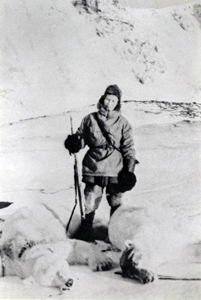Wanny Woldstad – the female trapper in Hornsund
By Jørn Henriksen, Kristin Prestvold
 (Image: The Norwegian Polar Institute) (Image: The Norwegian Polar Institute)
Wanny was a taxi-driver in Tromsø, in mainland Norway, in the 1930s. She often listened to stories told by the trappers who returned from Svalbard with a profit. They liked to spend some of it going to Ølhallen, the Mack brewery’s bar, by taxi.
In 1932 she was asked to join an expedition to Svalbard with Anders Sæterdal and she immediately accepted. “In two-three days I was converted from a taxi-driver in Tromsø to a female trapper on the way to Svalbard onboard Maiblomsten”.
In the beginning many of the experienced trappers were sceptical to her participation and abilities as a trapper in the harsh conditions. At 157 cm tall, she was a small woman, but she showed great drive and eagerness to learn and proved that this lifestyle was right for her. The following two years she brought her two sons to Hornsund – Alf and Bjørvik Jacobsen – who later became experienced trappers in Svalbard.
Wanny used Hyttevika as her main station. Isbjørnhamna, close to the site of today’s Polish Research Station, was the closest satellite station – it was near here that Wanny shot her first bear, on 12 December 1932. Fuglefjell (Gnålodden) was her second satellite station. In Hyttevika there was a contraption set up to catch polar bears called Signalen (the Signal):
“…The Signal is a simple but highly effective contraption: A stick of about 2 meters is planted in the ground about 60-70 meters from the house. A blubber bait is attached by a strong string halfway up the stick. The string is led over a reel at the top of the stick and then over to the house and through a hole in the wall into the innermost room. Here the string is attached to a wooden stick stuck into the hole from the outside. A few empty milk-cans are hung on the stick inside the room,constituting the alarm.” (Woldstad 1956).
When the Signal went off she sneaked silently to the loophole, rifle in hand, to shoot the bear. Because of The Signal the dogs had to sleep indoors to avoid scaring away approaching polar bears.
|